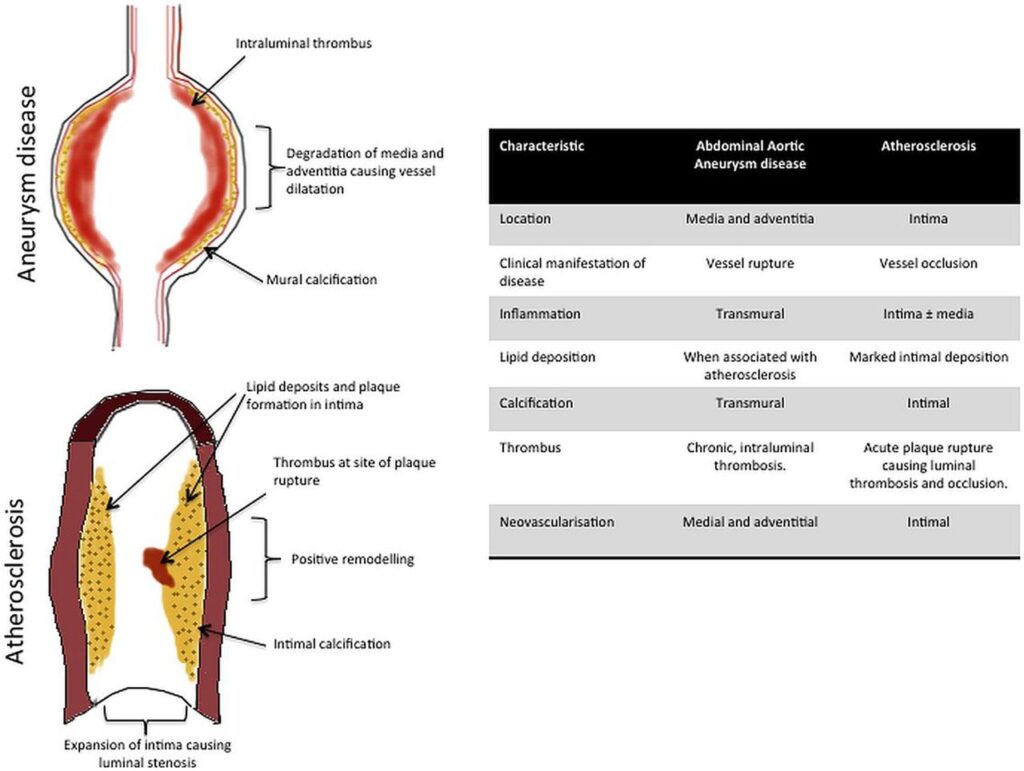An aortic aneurysm refers to the abnormal bulging or weakening of the wall of the aorta, the largest artery in the human body. This condition can occur in two primary forms: abdominal aortic aneurysm and thoracic aortic aneurysm. If left untreated, these aneurysms can lead to life-threatening complications such as rupture, which may result in severe internal bleeding. Understanding the causes, symptoms, diagnostic methods, and treatment options is crucial for managing this potentially dangerous condition.

What is an Aortic Aneurysm?
The aorta is the main blood vessel that carries oxygen-rich blood from the heart to the rest of the body. An aneurysm occurs when a section of the aorta weakens and begins to expand or bulge outward. Depending on its location, an aortic aneurysm can be classified into two types:
- Abdominal Aortic Aneurysm: Occurs in the part of the aorta that passes through the abdomen.
- Thoracic Aortic Aneurysm: Occurs in the part of the aorta that runs through the chest cavity.
Both types share similar underlying causes but differ in terms of symptoms, risk factors, and treatment approaches.
Causes of Aortic Aneurysms
The exact cause of an aortic aneurysm is often multifactorial, involving a combination of genetic, environmental, and lifestyle factors. Below are some of the most common causes:
1. Atherosclerosis
Atherosclerosis, or the buildup of plaque in the arteries, is one of the leading causes of aortic aneurysms. Plaque consists of cholesterol, fat, and other substances that harden and narrow the arteries over time. This process weakens the walls of the aorta, making them more susceptible to bulging.
2. High Blood Pressure
Prolonged high blood pressure places excessive stress on the walls of the aorta. Over time, this constant pressure can weaken the arterial walls, increasing the likelihood of an aneurysm forming.
3. Genetic Factors
Certain inherited conditions, such as Marfan syndrome, Ehlers-Danlos syndrome, and Loeys-Dietz syndrome, can predispose individuals to aortic aneurysms. These conditions affect the connective tissues in the body, including those in the aorta, making them weaker and more prone to damage.
4. Smoking
Smoking is a significant risk factor for both types of aortic aneurysms. The chemicals in tobacco smoke can damage the lining of the arteries and accelerate the progression of atherosclerosis, further weakening the aortic wall.
5. Age and Gender
Aortic aneurysms are more common in older adults, particularly men over the age of 65. Men are also at a higher risk compared to women, although women tend to experience more severe complications if an aneurysm ruptures.
6. Infections and Inflammation
In rare cases, infections such as syphilis or salmonella can lead to inflammation of the aortic wall, resulting in an aneurysm. Additionally, inflammatory diseases like giant cell arteritis can weaken the aorta and contribute to aneurysm formation.
Symptoms of Aortic Aneurysms
Aortic aneurysms often develop slowly over time and may not cause noticeable symptoms until they become large or rupture. However, some individuals may experience warning signs depending on the type and location of the aneurysm.
1. Abdominal Aortic Aneurysm Symptoms
For abdominal aortic aneurysms, symptoms may include:
- A pulsating sensation near the navel
- Deep, constant pain in the abdomen or on the side of the abdomen
- Back pain
If the aneurysm ruptures, symptoms can become severe and life-threatening, including:
- Sudden, intense abdominal or back pain
- Low blood pressure
- Rapid heart rate
- Dizziness or fainting
2. Thoracic Aortic Aneurysm Symptoms
Thoracic aortic aneurysms may present with the following symptoms:
- Chest pain or discomfort
- Back pain
- Shortness of breath
- Hoarseness or difficulty swallowing
As with abdominal aortic aneurysms, a rupture of a thoracic aortic aneurysm can lead to catastrophic consequences, including shock and death.
Diagnosis of Aortic Aneurysms
Early detection of an aortic aneurysm is critical to preventing complications. Several diagnostic tools are available to identify and evaluate the condition.
1. Physical Examination
During a routine physical exam, a healthcare provider may detect an abdominal aortic aneurysm by feeling a pulsating mass in the abdomen. For thoracic aortic aneurysms, a stethoscope may reveal abnormal sounds in the chest.
2. Imaging Tests
Imaging tests are essential for confirming the presence and size of an aneurysm. Common imaging techniques include:
- Ultrasound: Uses sound waves to create images of the aorta and is often the first test used to diagnose abdominal aortic aneurysms.
- Computed Tomography (CT) Scan: Provides detailed cross-sectional images of the aorta and helps determine the size, shape, and location of the aneurysm.
- Magnetic Resonance Imaging (MRI): Offers highly detailed images of the aorta and surrounding structures without using radiation.
- X-rays: While less commonly used, chest X-rays may reveal abnormalities in the thoracic aorta.
3. Screening Programs
Screening programs are recommended for individuals at high risk of developing an aortic aneurysm, such as older men with a history of smoking. Regular screening can help detect aneurysms early, allowing for timely intervention.
Treatment Options for Aortic Aneurysms
The treatment approach for an aortic aneurysm depends on several factors, including the size and location of the aneurysm, the presence of symptoms, and the patient’s overall health. Treatment options range from monitoring and lifestyle changes to surgical interventions.
1. Monitoring and Observation
Small aneurysms that do not cause symptoms are often monitored regularly through imaging tests. During this period, patients are advised to adopt healthy lifestyle changes to reduce their risk of complications.
2. Medications
Medications may be prescribed to manage underlying conditions that contribute to the development of an aortic aneurysm. Common medications include:
- Blood Pressure Medications: Help lower blood pressure and reduce stress on the aortic wall.
- Cholesterol-Lowering Drugs: Prevent the progression of atherosclerosis by reducing cholesterol levels.
- Smoking Cessation Aids: Encourage patients to quit smoking, which is a major risk factor for aneurysm growth.
3. Surgical Repair
Surgical repair is typically recommended for larger aneurysms or those that show signs of rapid growth. There are two main types of surgical procedures:
- Open Surgery: Involves replacing the weakened section of the aorta with a synthetic graft. This procedure is invasive and requires a longer recovery period.
- Endovascular Aneurysm Repair (EVAR): A minimally invasive procedure where a stent graft is inserted through small incisions in the groin and guided to the site of the aneurysm. EVAR has a shorter recovery time compared to open surgery.
4. Emergency Treatment for Ruptured Aneurysms
A ruptured aortic aneurysm is a medical emergency that requires immediate surgical intervention. Without prompt treatment, the mortality rate is extremely high. Emergency surgery aims to stop the bleeding and repair the damaged section of the aorta.
Preventing Aortic Aneurysms
While not all cases of aortic aneurysms can be prevented, certain measures can significantly reduce the risk of developing this condition:
- Maintain a healthy blood pressure through diet, exercise, and medication if necessary.
- Quit smoking and avoid exposure to secondhand smoke.
- Eat a balanced diet low in saturated fats and cholesterol to prevent atherosclerosis.
- Engage in regular physical activity to improve cardiovascular health.
- Attend routine medical check-ups, especially if you have a family history of aortic aneurysms.
By adopting these preventive strategies, individuals can lower their risk of developing an aortic aneurysm and improve their overall quality of life.





